ST NICHOLAS. A sweet building with its cobbled walls, its one big old tiled roof over nave and chancel, and its totally shingled W tower, whose pyramid roof starts lower than the ridge of the tile-roof. Architecturally the tower is of great interest. It represents a type familiar in Essex but unique in Huntingdonshire. It is entirely timber-framed, with heavy posts along the S and N walls, four tie-beams, two across the space, two against the E and W walls, and scissor-bracing as well as wind-braces against the walls. The impression is confusing but powerful. Is the tower of c.1500, or earlier? Dating in Essex has recently gone earlier - thanks to radio carbon. The building itself is E.E. - see the chancel N lancet with continuous outer mouldings and the small DOUBLE PISCINA. The nave N doorway has a finely moulded arch. - BENCHES. With summarily shaped poppyheads. - (SCREEN. Original dado. GMCH).
HAIL WESTON. It gives us a delightful peep of Old England from the porch of its church, and it appears as a piece of Old England in Michael Drayton’s poetic tour of the kingdom. Here he found two wells of which he was told that they were once two fair nymphs beloved by sylvan gods:
When this whole country’s face was foresty, and we
Lived loosely in the wilds which now thus peopled be,
Oft interchanged we sigh, oft amourous looks we sent,
Oft whispering our dear loves, our thoughts oft did we vent
Among the secret shades, oft in the groves did play,
And in our sports our joys and sorrows did bewray.
Alas the tears of one god fell and made the well salt, so that the god gave it the power of healing dim sight, and the other well was given the power of healing leprosy.
Long before Drayton listened to this story and wrote his Polyolbion these queer creatures were sitting on the buttresses looking across the churchyard. It is one of the rare villages with a timber tower, many of its great posts as strong today as they were 400 years ago. It has a spire of oak shingles.
The fine roof of the nave is 400 years old and has carved roses looking very small so high up. A group of 16th century benches have carved ends and poppyheads, the screen (which has lost its superstructure and has suffered much mutilation) is 15th century, the altar table was carved during the Civil War, and the double piscina and the font have been in the church since the Conqueror’s day.
When this whole country’s face was foresty, and we
Lived loosely in the wilds which now thus peopled be,
Oft interchanged we sigh, oft amourous looks we sent,
Oft whispering our dear loves, our thoughts oft did we vent
Among the secret shades, oft in the groves did play,
And in our sports our joys and sorrows did bewray.
Alas the tears of one god fell and made the well salt, so that the god gave it the power of healing dim sight, and the other well was given the power of healing leprosy.
Long before Drayton listened to this story and wrote his Polyolbion these queer creatures were sitting on the buttresses looking across the churchyard. It is one of the rare villages with a timber tower, many of its great posts as strong today as they were 400 years ago. It has a spire of oak shingles.
The fine roof of the nave is 400 years old and has carved roses looking very small so high up. A group of 16th century benches have carved ends and poppyheads, the screen (which has lost its superstructure and has suffered much mutilation) is 15th century, the altar table was carved during the Civil War, and the double piscina and the font have been in the church since the Conqueror’s day.

No comments:
Post a Comment